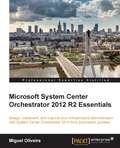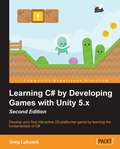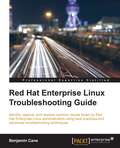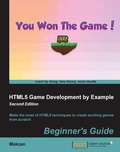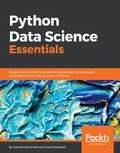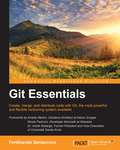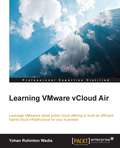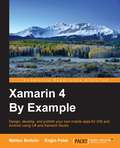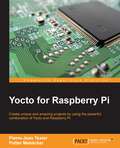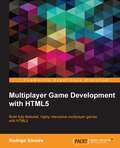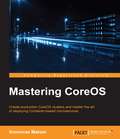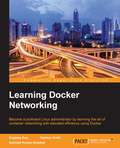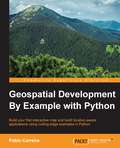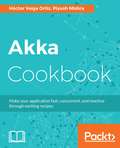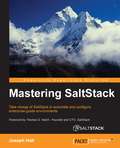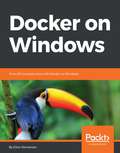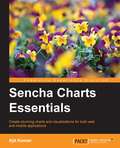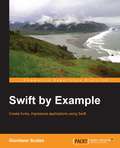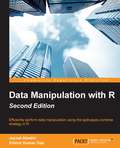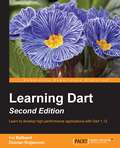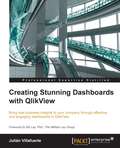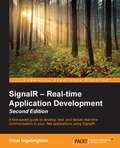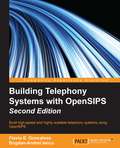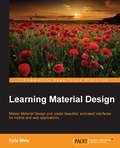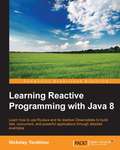- Table View
- List View
Microsoft System Center Orchestrator 2012 R2 Essentials
by Miguel OliveiraThis book is targeted at those who want to gain time in their administrative tasks and profit from it to also improve their environment by reaching a more autonomous infrastructure.
Learning C# by Developing Games with Unity 5.x - Second Edition
by Greg LukosekDevelop your first interactive 2D platformer game by learning the fundamentals of C# About This Book * Get to grips with the fundamentals of scripting in C# with Unity * Create an awesome, 2D platformer game from scratch using the principles of object-oriented programming and coding in C# * This is a step-by-step guide to learn the fundamentals of C# scripting to develop GameObjects and master the basics of the new UI system in Unity Who This Book Is For The book is targeted at beginner level Unity developers with no programming experience. If you are a Unity developer and you wish to learn how to write C# scripts and code by creating games, then this book is for you. What You Will Learn * Understand the fundamentals of variables, methods, and code syntax in C# * Get to know about techniques to turn your game idea into working project * Use loops and collections efficiently in Unity to reduce the amount of code * Develop a game using the object-oriented programming principles * Generate infinite levels for your game * Create and code a good-looking functional UI system for your game * Publish and share your game with users In Detail Unity is a cross-platform game engine that is used to develop 2D and 3D video games. Unity 5 is the latest version, released in March 2015, and adds a real-time global illumination to the games, and its powerful new features help to improve a game's efficiency. This book will get you started with programming behaviors in C# so you can create 2D games in Unity. You will begin by installing Unity and learning about its features, followed by creating a C# script. We will then deal with topics such as unity scripting for you to understand how codes work so you can create and use C# variables and methods. Moving forward, you will find out how to create, store, and retrieve data from collection of objects. You will also develop an understanding of loops and their use, and you'll perform object-oriented programming. This will help you to turn your idea into a ready-to-code project and set up a Unity project for production. Finally, you will discover how to create the GameManager class to manage the game play loop, generate game levels, and develop a simple UI for the game. By the end of this book, you will have mastered the art of applying C# in Unity. Style and approach This is a step-by-step guide to developing a game from scratch by applying the fundamentals of C# and Unity scripting.
Red Hat Enterprise Linux Troubleshooting Guide
by Benjamin CaneIdentify, capture and resolve common issues faced by Red Hat Enterprise Linux administrators using best practices and advanced troubleshooting techniquesAbout This BookDevelop a strong understanding of the base tools available within Red Hat Enterprise Linux (RHEL) and how to utilize these tools to troubleshoot and resolve real-world issuesGain hidden tips and techniques to help you quickly detect the reason for poor network/storage performanceTroubleshoot your RHEL to isolate problems using this example-oriented guide full of real-world solutionsWho This Book Is ForIf you have a basic knowledge of Linux from administration or consultant experience and wish to add to your Red Hat Enterprise Linux troubleshooting skills, then this book is ideal for you. The ability to navigate and use basic Linux commands is expected.What You Will LearnIdentify issues that need rapid resolution against long term root cause analysisDiscover commands for testing network connectivity such as telnet, netstat, ping, ip and curlSpot performance issues with commands such as top, ps, free, iostat, and vmstatUse tcpdump for traffic analysisRepair a degraded file system and rebuild a software raidIdentify and troubleshoot hardware issues using dmesgTroubleshoot custom applications with strace and knowledge of Linux resource limitationsIn DetailRed Hat Enterprise Linux is an operating system that allows you to modernize your infrastructure, boost efficiency through virtualization, and finally prepare your data center for an open, hybrid cloud IT architecture. It provides the stability to take on today's challenges and the flexibility to adapt to tomorrow's demands.In this book, you begin with simple troubleshooting best practices and get an overview of the Linux commands used for troubleshooting. The book will cover the troubleshooting methods for web applications and services such as Apache and MySQL. Then, you will learn to identify system performance bottlenecks and troubleshoot network issues; all while learning about vital troubleshooting steps such as understanding the problem statement, establishing a hypothesis, and understanding trial, error, and documentation. Next, the book will show you how to capture and analyze network traffic, use advanced system troubleshooting tools such as strace, tcpdump & dmesg, and discover common issues with system defaults.Finally, the book will take you through a detailed root cause analysis of an unexpected reboot where you will learn to recover a downed system.Style and approachThis is an easy-to-follow guide packed with examples of real-world core Linux concepts. All the topics are presented in detail while you're performing the actual troubleshooting steps.
HTML5 Game Development by Example: Beginner's Guide - Second Edition
by MakzanThis book is for web designers who have a basic knowledge of HTML, CSS, and JavaScript and want to create Canvas or DOM-based games that run on browsers.
Python Data Science Essentials
by Alberto Boschetti Luca MassaronIf you are an aspiring data scientist and you have at least a working knowledge of data analysis and Python, this book will get you started in data science. Data analysts with experience of R or MATLAB will also find the book to be a comprehensive reference to enhance their data manipulation and machine learning skills.
Git Essentials
by Ferdinando Santacroce<P><P>Create, merge, and distribute code with Git, the most powerful and flexible versioning system available <P><P>About This Book <P><P>Master all the basic concepts of Git to protect your code and make it easier to evolve <P><P>Use Git proficiently, and learn how to resolve day-by-day tasks easily <P><P>A step-by-step guide, packed with examples to help you learn and work with Git internals <P><P>Who This Book Is For <P><P>If you are a software developer with little or no experience of versioning systems, or are familiar with other centralized versioning systems, then this book is for you. If you have some experience working with command lines or using Linux admin or just using Unix and want to know more about Git, then this book is ideal for you. <P><P>What You Will Learn <P><P>Create, branch, and merge a local repository <P><P>Transport your work to a remote repository working in a centralized manner <P><P>Organize your source code using feature branches <P><P>Organize the development flow <P><P>Get a meaningful changelog using clear commit messages <P><P>Collaborate with teammates without any impediments <P><P>Experiment with your code without affecting functional code files <P><P>Explore some tools used to migrate to Git from other versioning systems without losing your development history <P><P>Extend your knowledge of Git with some useful resources <P><P>In Detail <P><P>Since its inception, Git has attracted skilled developers due to its robust, powerful, and reliable features. Its incredibly fast branching ability transformed a piece of code from a niche tool for former Linux Kernel developers into a mainstream distributed versioning system. Like most powerful tools, Git can be hard to approach since it has a lot of commands, subcommands, and options that easily confuse newcomers. The main purpose of Git Essentials is to help you overcome this fear and become adept at all basic tasks in Git. This book starts with an introduction to version control systems, and after this you'll delve deeply into the essentials of Git. This serves as a primer for the topics to follow such as branching and merging, creating and managing a GitHub personal repository, and fork and pull requests. You will then learn the art of cherry-picking, taking only commits you like, followed by Git blame. Finally, you'll learn how to migrate from SVN using Git tools or TortoiseGit and migrate from other VCSs, concluding with a collection of resources, links, and appendices.
Learning VMware vCloud Air
by Yohan Rohinton WadiaThis book is intended for cloud engineers or administrators who wish to explore and gain hands-on experience of VMware vCloud Air.<P><P> To make the most of this book, it would be beneficial to have a bit of familiarity with basic VMware vCloud concepts, but no prior experience is required.
Xamarin 4 By Example
by Engin Polat Matteo BortoluDesign, develop, and publish your own mobile apps for iOS and Android using C# and Xamarin Studio About This Book * Explore the exciting features of Xamarin Studio while learning to develop your own applications * Develop a complete application from conceptualization through to publishing it on the app store * The book walks you through the basics of cross-platform development with Xamarin using examples and best practices and tips for cross platform solutions. Who This Book Is For If you want to develop your own applications and want to explore the features of Xamarin Studio, then this is the book for you. It is expected that you have a basic understanding of technologies in mobile development, but prior knowledge of Xamarin is not required. What You Will Learn * Understand the software development lifecycle for mobile applications * Use Xamarin Studio and its wide range of features to write your programs in C# * Use different options to create multi-platform applications using Xamarin and develop a cross-platform extension method * Work with Xamarin forms and various UI controls * Integrate synchronous and asynchronous communication module within your app * Render images to work with Android and iOS * Link a third-party application to your solution In Detail The mobile app market is increasing exponentially every year. Xamarin Studio with its modern and powerful IDEs makes creating applications a lot easier by simplifying the development process. Xamarin will allow you and your team to create native applications by taking advantage of one of the most evolved programming language in the world: C#. This book will provide you with the basic skills you need to start developing mobile apps using C# and Xamarin. By working through the examples in each chapter, you will gain hands-on experience of creating a complete app that is fully functional by all means. Finally, you will learn to publish the app you created on the app market. Each project in this book will take you one step closer to becoming a professional app developer. Style and approach The step-by-guide will walk you through the process of creating an application of with the help of small projects that will teach you everything you need to know to build a complete application of your own.
Yocto for Raspberry Pi
by Petter Mabacker Pierre-Jean TexierCreate unique and amazing projects by using the powerful combination of Yocto and Raspberry Pi About This Book * Set up and configure the Yocto Project efficiently with Raspberry Pi * Deploy multimedia applications from existing Yocto/OE layers * An easy-to-follow guide to utilize your custom recipes on your Raspberry Pi Who This Book Is For If you are a student or a developer of embedded software, embedded Linux engineer or embedded systems in competence with Raspberry Pi and want to discover the Yocto Project, then this book is for you. Experience with Yocto is not needed. What You Will Learn * Explore the basic concept of Yocto's build system and how it is organized in order to use it efficiently with Raspberry Pi * Generate your first image with Yocto for the Raspberry Pi * Understand how to customize your Linux kernel within the Yocto Project * Customize your image in order to integrate your own applications * Write your own recipes for your graphical applications * Integrate a custom layer for the Raspberry Pi In Detail The Yocto Project is a Linux Foundation workgroup, which produces tools (SDK) and processes (configuration, compilation, installation) that will enable the creation of Linux distributions for embedded software, independent of the architecture of embedded software (Raspberry Pi, i.MX6, and so on). It is a powerful build system that allows you to master your personal or professional development. This book presents you with the configuration of the Yocto Framework for the Raspberry Pi, allowing you to create amazing and innovative projects using the Yocto/OpenEmbedded eco-system. It starts with the basic introduction of Yocto's build system, and takes you through the setup and deployment steps for Yocto. It then helps you to develop an understanding of Bitbake (the task scheduler), and learn how to create a basic recipe through a GPIO application example. You can then explore the different types of Yocto recipe elements (LICENSE, FILES, SRC_URI, and so on). Next, you will learn how to customize existing recipes in Yocto/OE layers and add layers to your custom environment (qt5 for example). Style and approach A step by step guide covering the fundamentals to create amazing new projects with Raspberry Pi and Yocto.
Multiplayer Game Development with HTML5
by Rodrigo SilveiraIf you are a HTML5 game developer who can make basic single-player games and you are now ready to incorporate multiplayer functionality in your games as quickly as possible, then this book is ideal for you.
Mastering CoreOS
by Sreenivas MakamCreate production CoreOS clusters and master the art of deploying Container-based microservices About This Book * Confidently deploy distributed applications and effectively manage distributed infrastructure using Containers and CoreOS * Build secure, scalable CoreOS clusters to deploy distributed applications using open source technologies and industry best practices * Every concept and technology in this book is illustrated with practical examples that can be used in both development and production environments. Who This Book Is For This book is intended for Cloud application developers and Cloud infrastructure administrators. If you are looking to deploy a CoreOS cluster or you already have a CoreOS cluster that you want to manage better in terms of performance, security, and scaling, then this book is perfect for you. To follow the hands-on stuff, you need to have a Google and an AWS Cloud account and be able to run CoreOS VMs on your machine. A basic understanding of public and private clouds, Containers, Docker, Linux, and CoreOS is required. What You Will Learn * Install CoreOS on a VM, on the Cloud, and bare metal, and find out how to keep your cluster secure and up to date * Configure and troubleshoot key CoreOS services, such as etcd, systemd, and fleet, for distributed application deployment * Study container networking using CoreOS Flannel and other solutions, such as Docker libnetwork, Weave, and Calico * Explore the container filesystem and container volume management using Docker volume, NFS, GlusterFS, and Flocker * Get to know the internals of container technologies such as Docker, Rkt, and Container orchestration using Openstack, Kubernetes and Docker native solutions * Troubleshoot CoreOS cluster and Containers using monitoring and logging tools and master production techniques such as staging, security, and automation In Detail CoreOS makes Google and Amazon-style Cloud infrastructure available for anyone building their own private Cloud. This book covers the CoreOS internals and the technologies used in the deployment of container-based distributed applications. It starts with an overview of CoreOS and distributed application development while sharing knowledge on related technologies. Critical CoreOS services and networking and storage considerations for CoreOS are covered next. In latter half of the book, you will learn about Container runtime systems such as Docker and Rkt and Container Orchestration using Kubernetes. You will also find out about the integration of popular orchestration solutions such as OpenStack, the AWS Container service, and the Google Container Engine with CoreOS and Docker. Lastly, we cover troubleshooting as well as production considerations. Style and approach This is an easy-to-follow, comprehensive guide that covers both basic and advanced concepts. All topics are illustrated with practical examples that can be used in both simulation and production environments.
Learning Docker Networking
by Rajdeep Dua Santosh Kumar Konduri Vaibhav KohliBecome a proficient Linux administrator by learning the art of container networking with elevated efficiency using Docker About This Book * Set up, configure, and monitor a virtual network of containers using a bridge network and virtual switches * Master the skill of networking Docker Containers using frameworks such as Kubernetes, Docker Swarm, and Mesosphere * Acquire hands-on experience through practical examples of Docker networking spanning multiple containers, over multiple hosts, clubbed with various frameworks Who This Book Is For If you are a Linux administrator who wants to learn networking using Docker to ensure the efficient administration of core elements and applications, then this book is for you. Basic knowledge of LXC/Docker is assumed. What You Will Learn * Get to know the basics of networking and see how Docker networking works * Expose the strengths and weaknesses of the current Docker network implementation and third party landscape * Understand Docker networking spanning multiple containers over multiple hosts through practical examples * Observe the pitfalls of Docker networking and how to overcome them * Learn how Docker networking works for Docker Swarm and Kubernetes * Configure Networking using Docker's container network model (CNM) * Explore OpenvSwitch to connect contain In Detail Docker is a Linux container implementation that enables the creation of light weight portable development and production environments. These environments can be updated incrementally. Docker achieves this by leveraging containment principles like cgroups and Linux namespaces along with Overlay filesystem based portable images. Docker provides the networking primitives that allow administrators to specify how different containers network with each application and connect each of its components, then distribute them across a large number of servers and ensure coordination between them irrespective of the host or VM they are running in. This book will show you how to create, deploy, and manage a virtual network for connecting containers spanning single or multiple hosts. Style and approach This step-by-step guide covers the fundamentals relating to typical applications with a practical approach. There is a focus on providing the practical skills required to develop applications, with a summary of the key concepts where necessary.
Geospatial Development By Example with Python
by Pablo CarreiraBuild your first interactive map and build location-aware applications using cutting-edge examples in Python About This Book * Learn the full geo-processing workflow using Python with open source packages * Create press-quality styled maps and data visualization with high-level and reusable code * Process massive datasets efficiently using parallel processing Who This Book Is For Geospatial Development By Example with Python is intended for beginners or advanced developers in Python who want to work with geographic data. The book is suitable for professional developers who are new to geospatial development, for hobbyists, or for data scientists who want to move into some simple development. What You Will Learn * Prepare a development environment with all the tools needed for geo-processing with Python * Import point data and structure an application using Python's resources * Combine point data from multiple sources, creating intuitive and functional representations of geographic objects * Filter data by coordinates or attributes easily using pure Python * Make press-quality and replicable maps from any data * Download, transform, and use remote sensing data in your maps * Make calculations to extract information from raster data and show the results on beautiful maps * Handle massive amounts of data with advanced processing techniques * Process huge satellite images in an efficient way * Optimize geo-processing times with parallel processing In Detail From Python programming good practices to the advanced use of analysis packages, this book teaches you how to write applications that will perform complex geoprocessing tasks that can be replicated and reused. Much more than simple scripts, you will write functions to import data, create Python classes that represent your features, and learn how to combine and filter them. With pluggable mechanisms, you will learn how to visualize data and the results of analysis in beautiful maps that can be batch-generated and embedded into documents or web pages. Finally, you will learn how to consume and process an enormous amount of data very efficiently by using advanced tools and modern computers' parallel processing capabilities. Style and approach This easy-to-follow book is filled with hands-on examples that illustrate the construction of three sample applications of how to write reusable and interconnected Python code for geo-processing.
Akka Cookbook
by Hector Veiga Ortiz Piyush MishraLearn how to use the Akka framework to build effective applications in Scala About This Book • Covers a discussion on Lagom—the newest launched Akka framework that is built to create complex microservices easily • The recipe approach of the book allows the reader to know important and independent concepts of Scala and Akka in a seamless manner • Provides a comprehensive understanding of the Akka actor model and implementing it to create reactive web applications Who This Book Is For If you are a Scala developer who wants to build scalable and concurrent applications, then this book is for you. Basic knowledge of Akka will help you take advantage of this book. What You Will Learn • Control an actor using the ContolAware mailbox • Test a fault-tolerant application using the Akka test kit • Create a parallel application using futures and agents • Package and deploy Akka application inside Docker • Deploy remote actors programmatically on different nodes • Integrate Streams with Akka actors • Install Lagom and create a Lagom project In Detail Akka is an open source toolkit that simplifies the construction of distributed and concurrent applications on the JVM. This book will teach you how to develop reactive applications in Scala using the Akka framework. This book will show you how to build concurrent, scalable, and reactive applications in Akka. You will see how to create high performance applications, extend applications, build microservices with Lagom, and more. We will explore Akka's actor model and show you how to incorporate concurrency into your applications. The book puts a special emphasis on performance improvement and how to make an application available for users. We also make a special mention of message routing and construction. By the end of this book, you will be able to create a high-performing Scala application using the Akka framework. Style and approach This highly practical recipe-based approach will allow you to build scalable, robust, and reactive applications using the Akka framework.
Mastering SaltStack
by Joseph HallThis book is ideal for professionals who have been managing groups of servers, and want to learn how to add functionality and expand their tool set. This book will also explain some of the more advanced features of Salt, and explore how to use them to bring additional power to the fundamentals that the professionals have already been using.
Docker on Windows
by Elton StonemanLearn how to run new and old Windows applications in Docker containers. About This Book • Package traditional .NET Frameworks apps and new .NET Core apps as Docker images, and run them in containers for increased efficiency, portability, and security • Design and implement distributed applications that run across connected containers, using enterprise-grade open source software from public Docker images • Build a full Continuous Deployment pipeline for a .NET Framework application, and deploy it to a highly-available Docker swarm running in the cloud Who This Book Is For If you want to modernize an old monolithic application without rewriting it, smooth the deployment to production, or move to DevOps or the cloud, then Docker is the enabler for you. This book gives you a solid grounding in Docker so you can confidently approach all of these scenarios. What You Will Learn • Comprehend key Docker concepts: images, containers, registries, and swarms • Run Docker on Windows 10, Windows Server 2016, and in the cloud • Deploy and monitor distributed solutions across multiple Docker containers • Run containers with high availability and fail-over with Docker Swarm • Master security in-depth with the Docker platform, making your apps more secure • Build a Continuous Deployment pipeline by running Jenkins in Docker • Debug applications running in Docker containers using Visual Studio • Plan the adoption of Docker in your own organization In Detail Docker is a platform for running server applications in lightweight units called containers. You can run Docker on Windows Server 2016 and Windows 10, and run your existing apps in containers to get significant improvements in efficiency, security, and portability. This book teaches you all you need to know about Docker on Windows, from 101 to deploying highly-available workloads in production. This book takes you on a Docker journey, starting with the key concepts and simple examples of how to run .NET Framework and .NET Core apps in Windows Docker containers. Then it moves on to more complex examples—using Docker to modernize the architecture and development of traditional ASP.NET and SQL Server apps. The examples show you how to break up monoliths into distributed apps and deploy them to a clustered environment in the cloud, using the exact same artifacts you use to run them locally. To help you move confidently to production, it then explains Docker security, and the management and support options. The book finishes with guidance on getting started with Docker in your own projects, together with some real-world case studies for Docker implementations, from small-scale on-premises apps to very large-scale apps running on Azure. Style and approach Using a step-by-step approach, this book shows you how to use Docker on Windows. It includes practical examples and real-world technical and business scenarios that will help you effectively implement Docker in your environment.There are over 50 examples of Dockerized applications, using C# .NET projects as the source and packaging them into Docker images.
Sencha Charts Essentials
by Ajit KumarIf you are an Ext JS or Sencha Touch developer, designer, or architect who wants to build enterprise-scale data visualization capabilities using Sencha, then this book is ideal for you. You should have a knowledge of HTML, JavaScript, CSS, and Sencha Ext JS or Sencha Touch fundamentals, in particular. Some familiarity with SVG and HTML5 Canvas would be preferred, but not required.
Swift by Example
by Giordano ScalzoThis book is intended for those who want to learn to develop apps in Swift the right way. Whether you are an expert Objective-C programmer or new to this platform, you'll learn quickly, grasping the code of real-world apps to use Swift effectively. Prior experience in development for Apple devices would be helpful, but is not mandatory.
Data Manipulation with R - Second Edition
by Jaynal Abedin Kishor Kumar DasThis book is for all those who wish to learn about data manipulation from scratch and excel at aggregating data effectively. It is expected that you have basic knowledge of R and have previously done some basic administration work with R.
Learning Dart - Second Edition
by Dzenan Ridjanovic Ivo BalbaertLearn to develop high performance applications with Dart 1.10 About This Book * Develop apps for the modern web using Dart and HTML5 * Clarify and shorten your Dart code using enums * Build a complex UI for business applications with Dart's Polymer framework, based on web components Who This Book Is For If you want to become a developer for the modern web, or wish to add Dart to your tool belt, then this book is for you. The book assumes you have basic HTML experience and know how web applications work. Some previous programming experience, preferably in a modern language like C#, Java, Python, Ruby or JavaScript, will give you a head start. You can work with Dart on your preferred platform, be it Linux, Mac OS X or Windows. What You Will Learn * Structure your code using functions, classes, generics, packages and libraries * Use the power of modern browsers to process and store data * Make games by drawing, and using audio and video in the browser * Develop an application with a model-driven and spiral-paced approach * Discover the Observatory tools for profiling memory and CPU usage of Dart programs * Store your app's data in MySQL and MongoDB through Dart * Build powerful HTML5 forms, validate and store data in local storage, and use web components to build your own user interface * Run your Dart server on an App Engine Managed VM In Detail Dart is an open source programming language for the web, developed at Google, with a steadily growing community. It is a single language for both client and server, appropriate for the full range of devices on the web - including phones, tablets, laptops, and servers. It encompasses the lessons of the last two decades of web programming. This book will give you a thorough overview of Dart, taking you through its ecosystem, syntax, and development principles. With this book, you will build web games using HTML5, audio, and video, and also dive into processing and displaying data in HTML5 forms with Dart. You will also learn how web components fit together with HTML5, and how to apply them in business web applications of the future. You will discover how to store data on the client, communicate data between client and server with JSON, and store JSON data with MongoDB and MySQL. Stop solving new challenges with the same old tools - let Dart show you a whole new way. Style and approach This book provides you a project-based approach, with everything you need to start or enhance your career in the future of web development with Dart. It follows the spiral approach: each project builds up in successive spirals, adding new features in each step.
Creating Stunning Dashboards with QlikView
by Julian VillafuerteBring real business insights to your company through effective and engaging dashboards in QlikViewAbout This BookBuild outstanding dashboards that respond to your company's information needsPresent the data in efficient and innovative ways to promote insightsUnleash the true power of QlikView by creating engaging visualizationsWho This Book Is ForThis book is focused on QlikView developers with basic knowledge of scripting and layouts who want to improve their designing skills and build effective, eye-catching dashboards that deliver tangible value to their business.What You Will LearnBuild a comprehensive library of QlikView components to speed up your developmentsDefine a practical roadmap that will help you build business-driven dashboardsExplore the most effective and engaging ways to present dataApply the best practices in the field of data visualizationAvoid common pitfalls when creating bar, line and pie chartsCreate robust visualizations such as heat maps, histograms and scatter plotsIn DetailQlikView is one of the most powerful analytical tools in the market. Based on an in-memory associative model, it lets users freely navigate through the data, spot trends and make better decisions. This platform is capable of integrating a wide range of data sources like ERP systems, data warehouses or spreadsheets into a single application in order display dashboards with state-of-the-art visualizations.Creating Stunning Dashboards with QlikView is an easy to follow handbook that guides you through the process of creating an effective and engaging dashboard that delivers tangible value to the business. It starts with the identification of the business needs and the definition of the main KPIs, and takes you all the way to the application rollout.Throughout the book, you will learn how to apply some of the best practices in the field of data visualization, create a robust navigation schema, chose the best chart types for each scenario and many other things that will help you create effective dashboards that uncover all the stories behind the data.Style and approachThis easy-to-follow compilation of best practices, tips, and tricks will help you leverage your QlikView developments. Each section presents practical guidelines to help you create dashboards that are not only functional, but also engaging and compelling.
SignalR – Real-time Application Development - Second Edition
by Einar IngebrigtsenA fast-paced guide to develop, test, and deliver real-time communication in your .Net applications using SignalR About This Book * Build and test real-time apps in .Net using the new features of SignalR * Explore the fundamentals and the new methods and functions in the latest version of SignalR along with developing a complete application from scratch * A progressive, hands-on guide to gain an understanding of the SignalR framework Who This Book Is For If you are a .Net developer with good understanding of the .Net platform then this is an ideal book for you to learn how to build real-time apps using the SignalR framework. What You Will Learn * Explore the basic knowledge and understanding of SignalR * Get to know how to connect client to the server * Connecting a client with a server and setting a hub * Creating group connections together * Understand how to have state in the client to have specific operations * Securing SignalR connections * How to scale SignalR across multiple servers * Building a client for WPF * Building a client using Xamarin targeting Windows, iPhone and Android * Get to grips with monitoring the traffic in SignalR using Fiddler for Windows and Charles for OSX * Setting up code to host SignalR using OWIN In Detail With technology trends, demands on software have changed with more and more skilled users. Over the past few years, with services such as Facebook, Twitter and push notifications on smartphones, users are now getting used to being up to date with everything that happens all the time. With SignalR, the applications stay connected and will generate notifications when something happens either from the system or by other users thus giving new opportunities to enter into this new, exciting world of real-time application development. This is a step-by-step guide that follows a practical approach helping you as a developer getting to get started with SignalR by learning its fundamentals. It will help you through building real-time applications using the new methods and functions in the SignalR framework. Starting from getting persistent connections with the server, you will learn the basics of connecting a client to the server and how the messaging works. This will be followed by setting up a hub on the server and consuming it from a JavaScript client. Next you will be taught how you can group connections together to send messages. We will then go on to know how you can have state in the client to handle specific operations like connecting or disconnecting. Then, moving on you will learn how to secure your SignalR connections using OWIN and scaling SignalR across multiple servers. Next you will learn building a client for WPF and building a client using Xamarin that targets Windows Phone, iPhone and Android. Lastly, you will learn how to monitor the traffic in SignalR using Fiddler, Charles and hosting SignalR using OWIN. Style and approach This is an example- oriented and comprehensive guide to learning the fundamentals of SignalR to build real-time applications. It will help you build real-time applications on the .Net platform in a step-by-step manner along with giving teaching techniques to deal with possible performance bottlenecks and other key topics.
Building Telephony Systems with OpenSIPS - Second Edition
by Flavio E. Goncalves Bogdan-Andrei IancuBuild high-speed and highly scalable telephony systems using OpenSIPS About This Book * Install and configure OpenSIPS to authenticate, route, bill, and monitor VoIP calls * Gain a competitive edge using the most scalable VoIP technology * Discover the latest features of OpenSIPS with practical examples and case studies Who This Book Is For If you want to understand how to build a SIP provider from scratch using OpenSIPS, then this book is ideal for you. It is beneficial for VoIP providers, large enterprises, and universities. This book will also help readers who were using OpenSER but are now confused with the new OpenSIPS. Telephony and Linux experience will be helpful to get the most out of this book but is not essential. Prior knowledge of OpenSIPS is not assumed. What You Will Learn * Learn to prepare and configure a Linux system for OpenSIPS * Familiarise yourself with the installation and configuration of OpenSIPS * Understand how to set a domain and create users/extensions * Configure SIP endpoints and make calls between them * Make calls to and from the PSTN and create access control lists to authorize calls * Install a graphical user interface to simplify the task of provisioning user and system information * Implement an effective billing system with OpenSIPS * Monitor and troubleshoot OpenSIPS to keep it running smoothly In Detail OpenSIPS is a multifunctional, multipurpose signalling SIP server. SIP (Session Initiation Protocol) is nowadays the most important VoIP protocol and OpenSIPS is the open source leader in VoIP platforms based on SIP. OpenSIPS is used to set up SIP Proxy servers. The purpose of these servers is to receive, examine, and classify SIP requests. The whole telecommunication industry is changing to an IP environment, and telephony as we know it today will completely change in less than ten years. SIP is the protocol leading this disruptive revolution and it is one of the main protocols on next generation networks. While a VoIP provider is not the only kind of SIP infrastructure created using OpenSIPS, it is certainly one of the most difficult to implement. This book will give you a competitive edge by helping you to create a SIP infrastructure capable of handling tens of thousands of subscribers. Starting with an introduction to SIP and OpenSIPS, you will begin by installing and configuring OpenSIPS. You will be introduced to OpenSIPS Scripting language and OpenSIPS Routing concepts, followed by comprehensive coverage of Subscriber Management. Next, you will learn to install, configure, and customize the OpenSIPS control panel and explore dialplans and routing. You will discover how to manage the dialog module, accounting, NATTraversal, and other new SIP services. The final chapters of the book are dedicated to troubleshooting tools, SIP security, and advanced scenarios including TCP/TLS support, load balancing, asynchronous processing, and more. A fictional VoIP provider is used to explain OpenSIPS and by the end of the book, you will have a simple but complete system to run a VoIP provider. Style and approach This book is a step-by-step guide based on the example of a VoIP provider. You will start with OpenSIPS installation and gradually, your knowledge depth will increase.
Learning Material Design
by Kyle MewMaster Material Design and create beautiful, animated interfaces for mobile and web applications About This Book * Master the highly acclaimed Material Design paradigm and give your apps and pages the look that everyone is talking about * Get a mix of key theoretical concepts combined with enough practical examples to put each theory into practice so you can create elegant material interfaces with Android Studio and Polymer * Written by Kyle Mew, successful author with over a decade of mobile and web development experience, this book has both the touch of a developer as well as an experienced writer Who This Book Is For This book is ideal for web developers and designers who are interested in implementing Material Design in their mobile and web apps. No prior knowledge or experience of Material Design is required, but some familiarity with procedural languages such as Java and markup languages such as HTML will provide an advantage. What You Will Learn * Implement Material Design on both mobile and web platforms that work on older handsets and browsers * Design stylish layouts with the Material Theme * Create and manage cards, lists, and grids * Design and implement sliding drawers for seamless navigation * Coordinate components to work together * Animate widgets and create transitions and animation program flow * Use Polymer to bring Material Design to your web pages In Detail Google's Material Design language has taken the web development and design worlds by storm. Now available on many more platforms than Android, Material Design uses color, light, and movements to not only generate beautiful interfaces, but to provide intuitive navigation for the user. Learning Material Design will teach you the fundamental theories of Material Design using code samples to put these theories into practice. Focusing primarily on Android Studio, you'll create mobile interfaces using the most widely used and powerful material components, such as sliding drawers and floating action buttons. Each section will introduce the relevant Java classes and APIs required to implement these components. With the rules regarding structure, layout, iconography, and typography covered, we then move into animation and transition, possibly Material Design's most powerful concept, allowing complex hierarchies to be displayed simply and stylishly. With all the basic technologies and concepts mastered, the book concludes by showing you how these skills can be applied to other platforms, in particular web apps, using the powerful Polymer library. Style and approach Learning Material Design combines the theories behind material design with practical examples of how these can be implemented and further reinforcing the guidelines covering style, layout and structure.
Learning Reactive Programming with Java 8
by Nickolay Tsvetinov<P><P>Learn how to use RxJava and its reactive Observables to build fast, concurrent, and powerful applications through detailed examples <P><P>About This Book <P><P>Learn about Java 8's lambdas and what reactive programming is all about, and how these aspects are utilized by RxJava <P><P>Build fast and concurrent applications with ease, without the complexity of Java's concurrent API and shared states <P><P>Explore a wide variety of code examples to easily get used to all the features and tools provided by RxJava <P><P>Who This Book Is For <P><P>If you are a Java developer that knows how to write software and would like to learn how to apply your existing skills to reactive programming, this book is for you. <P><P>What You Will Learn <P><P>Discover what reactive programming is and how you can benefit from it <P><P>Get to grips with the new functional features of Java 8 and some functional theory <P><P>Create RxJava Observable instances from virtually any data source <P><P>Transform, filter, and accumulate your data using various RxJava operators <P><P>Combine multiple data sources in one dataset, using custom logic <P><P>Write concurrent programs with ease, scheduling actions on various workers <P><P>Learn about unit testing asynchronous RxJava logic <P><P>Extend RxJava by writing your own operators and factory methods <P><P>In Detail <P><P>Whether you are a Java expert or at a beginner level, you'll benefit from this book, because it will teach you a brand new way of coding and thinking. <P><P>The book starts with an explanation of what reactive programming is, why it is so appealing, and how we can integrate it in to Java. It continues by introducing the new Java 8 syntax features, such as lambdas and function references, and some functional programming basics. From this point on, the book focuses on RxJava in depth. It goes through creating Observables, transforming, filtering, and combining them, and concurrency and testing to finish with extending the library itself. <P><P>This book is a definite tutorial in RxJava filled with a lot of well-described examples. It explains reactive programming concepts in plain and readable language, without scientific formulas and terms.
